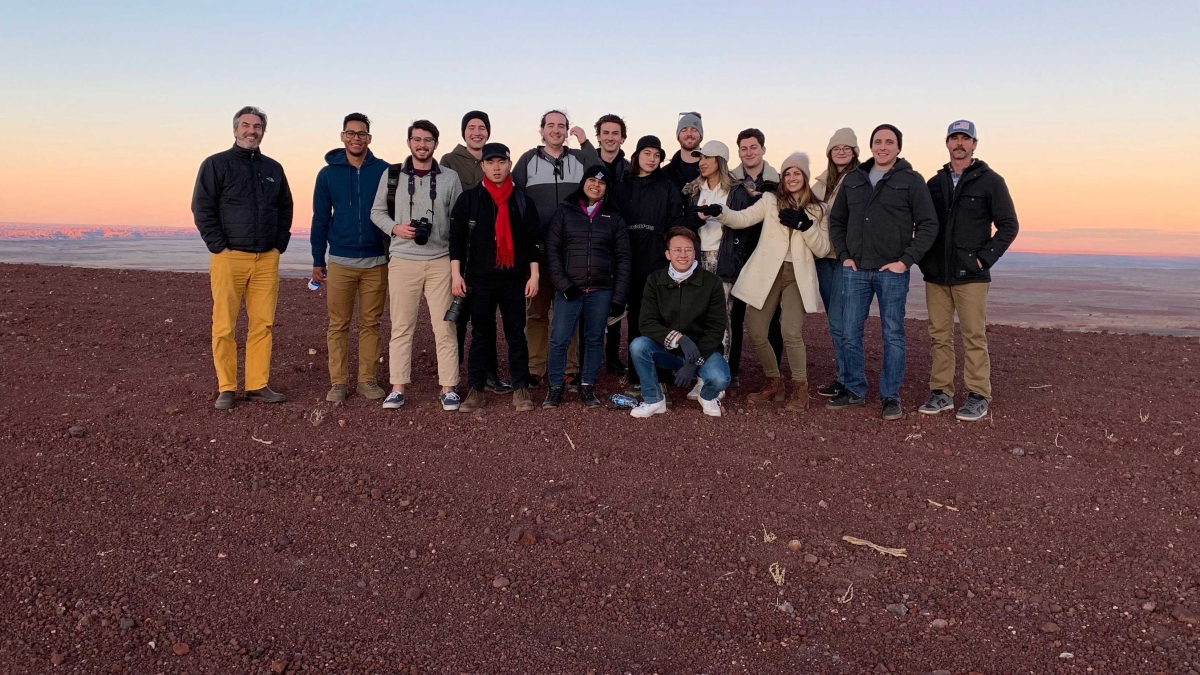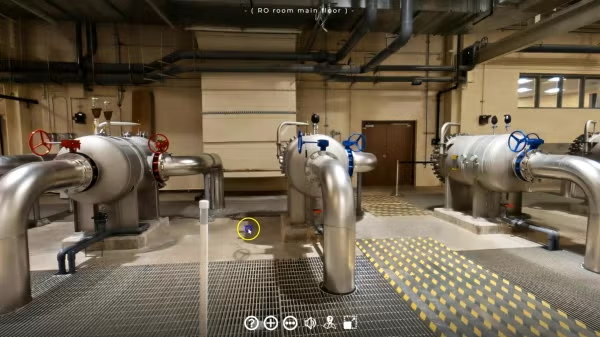ASU architecture students experience 'life-changing' Roden Crater during housing-design project

Sixteen Arizona State University architecture students were tapped to provide design work around one of the most important large-scale artworks in the world — Roden Crater, the installation created by James Turrell in northern Arizona.
The undergraduates participated in a fourth-year studio course this spring that had a unique assignment: propose designs for temporary housing for construction crews who are working on Roden Crater.
The students were able to visit the crater, an immersive observatory inside a dormant volcano that is seen by only a few hundred people every year. The artwork is still under construction and is not yet open to the public.
The experience was awe-inspiring, and the project was a challenge, according to Marc Neveu, head of the architecture program in The Design School at ASU.
The remote area has no access to power and water, and the housing had to be out of sight from the crater itself. The goal is to preserve the surrounding natural environment.
“So it was complicated for a whole list of reasons,” Neveu said.
About an hour drive from Flagstaff, Roden Crater is on a dirt road and remains closed to the public. Inside the crater, which is a volcanic cinder cone, Turrell has designed over 20 chambers and spaces to experience celestial events and seasonal alignments. At any one time, there are several dozen construction workers carrying out Turrell’s vision.
“James Turrell thought it would be interesting to think about temporary housing for these contractors,” Neveu said. “And we were thinking about other groups of people who could be working there — archeologists and students, who would all be short-term.
“So the question of community came up. How do you build community?”
About three weeks into the semester, the group visited Roden Crater, which has several installations within the cone, including a 900-foot-long tunnel that plays with the view at the end.
“Walking through the tunnel, I knew what was going to happen,” Neveu said. “I knew that the circle would become an eclipse, but there’s moment of magic when you see it that you just can’t describe.
“It’s an uncanny experience, and it’s hard to find the words.”
Dellan Raish was one of the students in the class.
“To be inside and experience that with your own perception and eyes was life-changing,” Raish said.
“The way he tunes each space to capture the light and give you a different perspective on the sky is like sensory overload.”
Each student in the class created their own version of a low-impact, flexible, temporary group of dwellings.
“In terms of construction, they looked at different things, like rammed earth, which has a zero carbon footprint,” Neveu said.
“The material is right there, and the walls can go back into the ground if people leave.”
Other students, including Nasrynn Chowdhury, proposed prefabricated dwellings.
“It had to be temporary so we weren’t meant to be building with concrete,” she said.
“I decided to do a series of structures that would be made in a factory and brought to the site. They would be on these steel screw-pile foundations so they didn’t touch the ground.”
The dwellings could be removed with nothing left on the ground except a few holes.
Chowdhury took a highly flexible approach.
“It has a movable kitchen that’s able to slide into each unit,” she said. “During the night you can make the space into a bedroom and during the day you can create a larger space with both units and slide the kitchen out.
“I understood there would be different needs. Construction workers might want to rest while students might want to be more social.”
Raish designed two rows of buildings with a courtyard in the middle.
“That was to save power and water and by turning off different wings of the buildings when people are not occupying them,” he said.
Seeing Turrell’s work was profound for the students.
“They balanced the extremely practical with the poetic and tried to not just think about the crater, but how a building orients a person in the landscape,” Neveu said.
“You see the Painted Desert miles away and the San Francisco Peaks miles away. The quality of the light and the quality of the sky is very different from here, and that informed a lot of the projects.”
After spring break, the course moved to Zoom because of the COVID-19 pandemic. The students used breakout rooms in the online platform to continue collaborating.
In a typical studio course, the end of the semester brings a review in which the students formally present their projects to three or four experts. Instead, this class had a huge Zoom gathering in which the students presented to 45 experts from around the world.
“Presenting in front of people can sometimes get the best of you,” Chowdhury said. “But because this was on Zoom, it felt a lot more interactive because everyone was seeing the same thing and they were able to write comments directly into it, which made it feel more like a workshop rather than not really understanding their feedback.”
Raish said that at the more formal presentations, students almost “black out.”
“Most of the time, students don’t remember what anyone is saying, but this was one of my best reviews because we could record it and watch it back,” he said.
The students’ proposals will be collected and presented to Turrell later this summer.
The architecture studio was part of a burgeoning partnership between Turrell and ASU that has led to the development of ongoing academic experimentation. Several ASU students visited Roden Crater last year as part of four pilot lab courses.
Neveu is teaching an iCourse starting July 1 called “James Turrell and Roden Crater: Working at the Intersection of Art, Design, Science and Technology,” which will examine the installation from different perspectives. The course has no prerequisites and is open to anyone.
While Roden Crater is open only to invited guests while under construction, anyone can experience Turrell’s work manipulating light and perception. “Air Apparent,” just south of Biodesign C on ASU’s Tempe campus, was installed in 2012 and is open to the public 24 hours a day. Part of Turrell’s Skyspace series, “Air Apparent” is best enjoyed at sunset.
Top photo: Marc Neveu (left), head of the architecture program in The Design School at ASU, and his students pose for a group photo near Roden Crater in northern Arizona. Photo courtesy of the Herberger Institute for Design and the Arts
More Environment and sustainability

Homes for songbirds: Protecting Lucy’s warblers in the urban desert
Each spring, tiny Lucy’s warblers, with their soft gray plumage and rusty crown, return to the Arizona desert, flitting through the mesquite branches in search of safe places to nest.But as urban…

Public education project brings new water recycling process to life
A new virtual reality project developed by an interdisciplinary team at Arizona State University has earned the 2025 WateReuse Award for Excellence in Outreach and Education. The national …

ASU team creates decision-making framework to improve conservation efficiency
Conserving the world’s ecosystems is a hard job — especially in times of climate change, large-scale landscape destruction and the sixth mass extinction. The job’s not made any easier by the fact…

